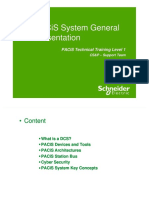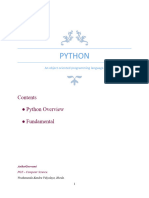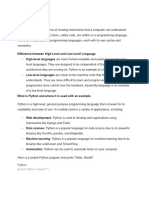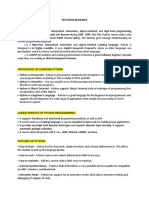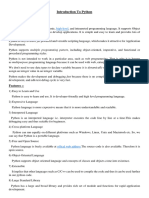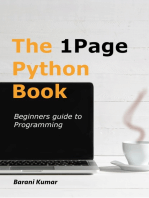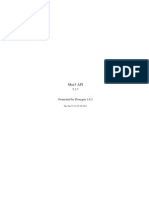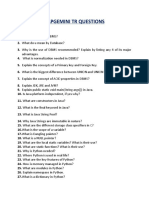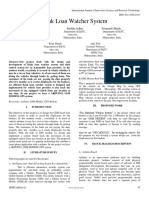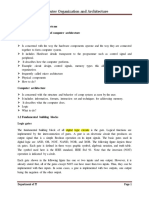Basic of Python Class VIII
Uploaded by
devyanshiaggarwal6919Basic of Python Class VIII
Uploaded by
devyanshiaggarwal6919Basic of Python
Languages of Computer:
1) Machine Language: It consist of binary digits in form of 0 and1
2) Assembly Language: it contains mnemonics
3) High level Language (HLL): It is a programming language that is designed to make
it easier for humans to understand and write.
Translator:
1) Assembler: It converts assembly language programs into machine language.
2) Compiler: It convert HLL program into machine language in one go
3) Interpreter: It convert HLL program into machine language line by line
Python: Python is a high level, object oriented, easy to learn language developed by Guido
Van Rossum in 1991.
Features of python:
1. Interpreted language: it converts Source code of high level language into machine code line
by line so it is called interpreted language.
2. Open source software and free
3. Platform independent language: It works on multiple platforms such as Linux, UNIX and
Windows
4. Easy to learn and use
5. Graphical user interface
6. Large Standard Library
Uses of python:
1. Used to web and internet application development
2. Scientific and Numeric calculation
3. Game Development
4. General Purpose software Development
Python works on two different modes:
a) Shell Mode: we can type one command at a time.
b) Script Mode: We can save multiple command with .py extension (F5 is the shortcut
key to run a python file
Tokens: The smallest individual unit in a program is called as Tokens
● Keywords :
● Identifiers(Name)
● Literals
● Operators
● Punctuators
Keywords: Python has some reserved words. These reserved words may not be
used as constant or variable or any other identifier names. Eg : input(), int , float, if, else
Identifier: An identifier is a name used to identify a variable, function, class,
module or other object.
Variable: variable is assigned a value; the variable can be used to access and
manipulate that value throughout a program.
Rules to define Variable :
● An identifier starts with a letter A to Z or a to z or an underscore ( _ )
● Python does not allow punctuation characters such as @, & and % within
identifiers.
● Keyword can never be identifier
● Python is a case sensitive programming language.
Literals/Constants: Literals are data items that have a fixed value.
Python allows several kinds of literals as
● String literals
● Numeric literals
● Boolean literals
● special literal
● None
Operator: Operators are special symbols which perform some computation. Operators and
operands form an expression.
Python operators can be classified as given below:
● Arithmetic operators (+,-,*,/,**,%)
● Relational operators (<,>,<=,>=,==,!=)
● Logical operators(And,or,not)
● Assignment operators
● Bitwise operators Identity operators
Data Types: Data type is a set of values and the allowable operations on those values.
Python has a great set of useful data types. Python’s data types are built in the core of the
language.eg integer, string, float, Boolean.
Punctuator: These are symbols that are used in a programming language to organize
programming sentence structures
Case Sensitive Programming: Case sensitivity describes a programming language's (C, C++,
Java, C#, Verilog, Ruby, Python and Swift) ability to distinguish between upper and lower case
versions of a letter.
Comment in Python:Comments are used to explain code, make it more readable, or to
temporarily disable a piece of code. Comments are ignored by the Python interpreter during
execution. There are two types of comments in Python: single-line comments (#) and multi-
line comments(‘’’.................................................’’’’)
Program Based on Python:
1. WAP to print total marks of 5 subjects
Eng=int(input("Enter the marks of English:"))
Hindi=int(input("Enter the marks of Hindi:"))
Math=int(input("Enter the marks of Maths:"))
Sc=int(input("Enter the marks of Science:"))
sst=int(input("Enter the marks of Social Studies:"))
total=Eng+Hindi+Math+Sc+sst
print("The total is",total)
2. WAP to program to calculate area of triangle
b=int(input("Enter the value of base:"))
h=int(input("Enter the value of Height:"))
area =0.5*b*h
print("The area is ",area)
3. WAP to program to calculate area of rectangle
l=int(input("Enter the value of len:"))
b=int(input("Enter the value of bre:"))
area =0.5*b*l
print("The area is ",area)
You might also like
- Acer Nitro AN517-41 - LA-L031P GH53Z REV1ANo ratings yetAcer Nitro AN517-41 - LA-L031P GH53Z REV1A118 pages
- Chapter - 1 - Python Overview and FundamentalsNo ratings yetChapter - 1 - Python Overview and Fundamentals14 pages
- UNIT-1 Introduction and syntax of Python ProgramNo ratings yetUNIT-1 Introduction and syntax of Python Program11 pages
- Getting Started Python Chapter 5 NEW 14-09-2024No ratings yetGetting Started Python Chapter 5 NEW 14-09-20246 pages
- Num Information US #111: (See US117 - 10xx Series System Memory Map.)No ratings yetNum Information US #111: (See US117 - 10xx Series System Memory Map.)9 pages
- Building An API in Rust With Rocket - Rs and Diesel - Rs (Clean Architecture) - by Brook Jeynes - MediumNo ratings yetBuilding An API in Rust With Rocket - Rs and Diesel - Rs (Clean Architecture) - by Brook Jeynes - Medium29 pages
- VSR, TiMOS) First Boot Provisioning - Networking in A Service Provider WayNo ratings yetVSR, TiMOS) First Boot Provisioning - Networking in A Service Provider Way6 pages
- Write Protected USB Format Tool Free Download - Format Read-Only USB EasilyNo ratings yetWrite Protected USB Format Tool Free Download - Format Read-Only USB Easily11 pages
- Num Information US #111: (See US117 - 10xx Series System Memory Map.)Num Information US #111: (See US117 - 10xx Series System Memory Map.)
- Building An API in Rust With Rocket - Rs and Diesel - Rs (Clean Architecture) - by Brook Jeynes - MediumBuilding An API in Rust With Rocket - Rs and Diesel - Rs (Clean Architecture) - by Brook Jeynes - Medium
- VSR, TiMOS) First Boot Provisioning - Networking in A Service Provider WayVSR, TiMOS) First Boot Provisioning - Networking in A Service Provider Way
- Write Protected USB Format Tool Free Download - Format Read-Only USB EasilyWrite Protected USB Format Tool Free Download - Format Read-Only USB Easily



